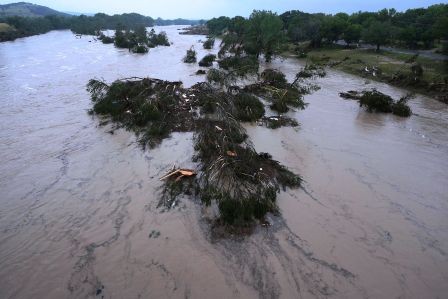The Texas flooding flash flood disaster has left the state reeling as the death toll continues to climb and search-and-rescue efforts intensify across the Hill Country. In the early hours of July 4, 2025, a sudden and catastrophic storm unleashed unprecedented rainfall across central Texas, triggering flash floods that have so far claimed at least 51 lives, including 15 children, and left dozens more missing. The hardest-hit areas, including Kerrville and Hunt along the Guadalupe River, remain under threat as more rain is forecast and emergency teams race against time to find survivors.
Unprecedented Rainfall and Sudden Devastation
The Texas flooding flash flood event began just after midnight on July 4, when heavy rains—far exceeding forecasts—pounded the region. Within a few hours, up to 15 inches of rain fell in some areas, causing the Guadalupe River to surge over 29 feet in Hunt and nearly 30 feet in Comfort. The rapid rise caught many off guard, including campers, residents, and local officials. The National Weather Service (NWS) issued its first flash flood warning at 1:14 a.m., but the river’s rise was so swift that many people had little time to react.
By sunrise, the devastation was clear. Entire neighborhoods were submerged, vehicles and homes swept away, and hundreds stranded. At Camp Mystic, a historic girls’ summer camp near Hunt, at least 27 girls were reported missing, sparking a massive search effort involving helicopters, drones, and dozens of rescue teams.
Read also-How Many Kids Died in Texas Flood: Latest Updates on Central Texas Tragedy
Key Point Summary
- Over 51 confirmed dead, including 15 children, with dozens still missing.
- More than 850 people rescued, many clinging to trees or rooftops.
- Guadalupe River rose over 29 feet in just hours, overwhelming communities.
- Camp Mystic, with 700 campers, suffered extensive damage and missing persons.
- Flash flood emergencies issued for Kerrville, Mason, and surrounding counties.
- Additional rain forecast, increasing risk of further flooding and complicating recovery.
Rescue Efforts and Community Response
Emergency crews, supported by local volunteers and federal agencies, have been working around the clock since Friday. Over 850 people have been rescued so far, including dramatic saves of individuals stranded in trees and on rooftops. In one remarkable case, a young girl survived by floating on a mattress for three hours before being found safe. The scale of the disaster has prompted Texas Governor Greg Abbott to request a federal disaster declaration, which President Trump has indicated will be granted.
The community response has been extraordinary, with residents opening their homes to the displaced and sharing resources. Social media platforms, especially Facebook and Instagram, have become lifelines for sharing updates, posting photos of missing loved ones, and coordinating volunteer efforts.
Table: Texas Flooding Flash Flood Impact (as of July 6, 2025)
| Statistic | Number/Detail |
|---|---|
| Confirmed deaths | 51+ |
| Children among deceased | 15 |
| People rescued | 850+ |
| Missing (Camp Mystic) | 27 girls |
| Peak river rise (Hunt) | 29+ feet |
| Rainfall in 24 hours | Up to 15 inches |
| Counties affected | 10+ |
| Active rescue teams | 9+ |
Questions Over Warnings and Preparedness
The Texas flooding flash flood disaster has also raised urgent questions about preparedness and the effectiveness of warning systems. While the NWS did issue flash flood warnings several hours before the worst flooding, many residents and officials say the alerts underestimated the severity and speed of the event. Staffing shortages at the NWS, following recent federal cuts, have been cited as a possible factor in delayed or insufficient warnings.
Local leaders have defended their response, noting the unpredictability of the weather system and the unprecedented rainfall totals. However, the tragedy has sparked calls for improvements in forecasting, communication, and evacuation protocols—especially for vulnerable locations like summer camps and low-lying neighborhoods.
Ongoing Threats and Looking Ahead
As of Sunday evening, the threat is far from over. The NWS has issued new flood watches for the region, warning that additional rainfall could exacerbate already dire conditions. Rivers remain swollen, and saturated ground increases the risk of further flash floods and landslides. Recovery efforts are being hampered by persistent rain, debris, and damaged infrastructure.
Authorities urge residents to avoid travel unless seeking higher ground and to heed all emergency warnings. With hundreds still unaccounted for, the search for missing persons continues, and officials warn that the death toll could rise further in the coming days.
Conclusion
The Texas flooding flash flood has become one of the deadliest natural disasters in recent state history, exposing vulnerabilities in both infrastructure and emergency response. As the search for survivors continues and communities begin to assess the full scale of the destruction, the focus shifts to recovery and rebuilding. The resilience and solidarity shown by Texans in the face of tragedy offer hope, but the lessons learned from this disaster will shape how the state prepares for future extreme weather events.
Stay tuned for the latest Texas flooding flash flood news and exclusive updates on rescue and recovery efforts. Share your thoughts in the comments—how has your community been affected?
